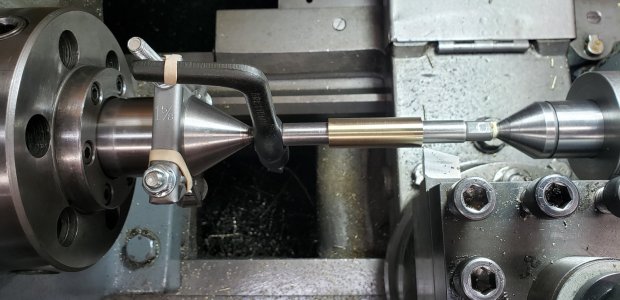Interesting, what type of bearings?
My understanding is that roller bearings, even ABEC 7/P4 grade precision ones usual have a tenth or so of runout, no?
Its a roller bearing. Agree about the tolerances, although they are the worst its suppose to be.... i.e. they can be better. The times i've worked with P4's, iirc, paying attention to lining up the marks, I've ended up with about a 1/2 a tenth.
A very skilled old boy I know used to work at Spar aerospace. They would make their own bearings up by sorting through bins of balls, off the shelf weren't good enough. He has the 1/1,000,000" comparator they used to sort the balls. I bought the 1/100,000" comparator from him.... have never used it, but it was too unique to walk by lol.) Point being, I don't know how the Swiss did these lathes, but there are ways to do bearings that might be better than off the shelf (even that really expensive P2 and P4 shelf. )
How do you get better than P2's on the races and bore? I'd guess spindles and machines with plane bearings. I have no motivation or reason to do so, but theoretically, you could make a plane bearing machine with only a small fraction of tenth runout to do the grinding and boring. DSG did that on some of their highest ends lathes for example (T17). Such a plain bearing can give you spindle that wouldn't flicker a tenths indicator needle, maybe as good as a 1/100,000 TIR? Just guessing
As evidence, here's an example I did in the home shop on the little schaublin. I ground the spindle (double taper) and then scraped the bronze bearing, and finally removed the miscropic burrs with a very small amount garnet fine abrasive (the stuff that breaks down). Run out is a small fraction of a tenth. No doubt Spar or Habegger or Schaublin could have done that or better.
So....armed with such a comparator, if you were suitably motivated to make the machines and spindles to do the boring and grinding (i'm certainly not, this is just chewing the fat), it would seem doable to make bearings better than P4 or P2.
Another example is Lodge & Shipley, arguably the top of the line cylindrical grinder. I've got the baby one and its all plane bearings, done that way to achieve the highest accuracy so the story goes.
See at about 16:10 here, spindle grind and bearing by yours truly. Barely any needle movement, home shop made spindle.
A long account of the headstock reconditioning
Return to Projects Reconditioning a Schaublin 70 – the Headstock Reconditioning a Schaublin 70 – Intro the Tailstock the Bed the Headstock the Slide Rest the Headstock A diminutive project of king sized proportions. It must have been run dry because the condition of the spindle bearing and the...
www.metallum.shop
The finished lathe





